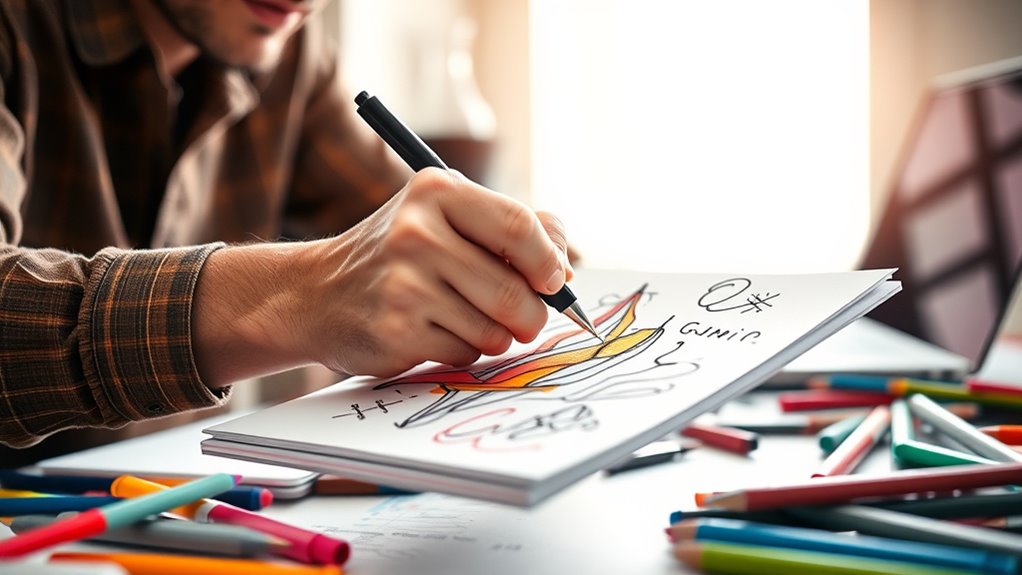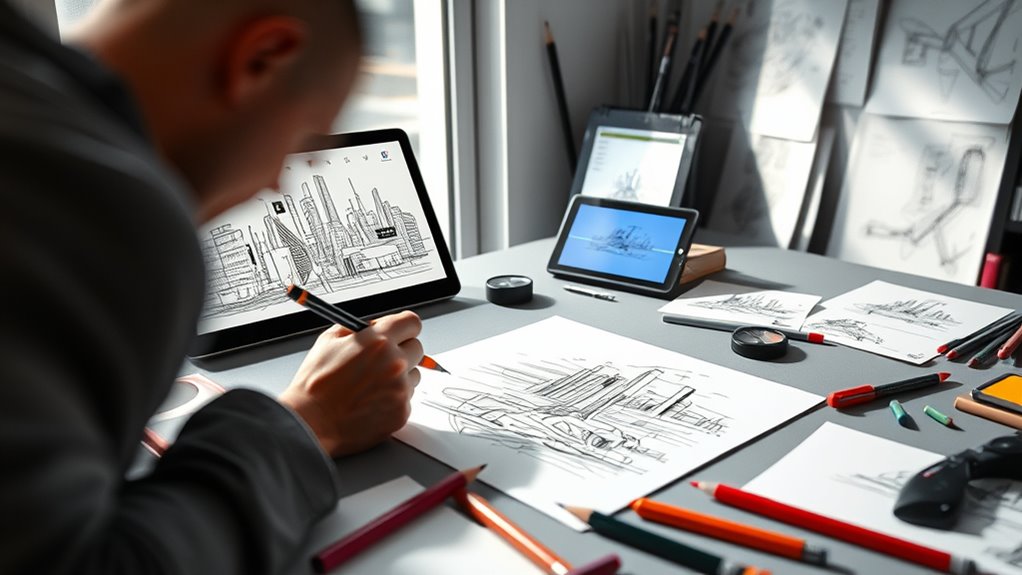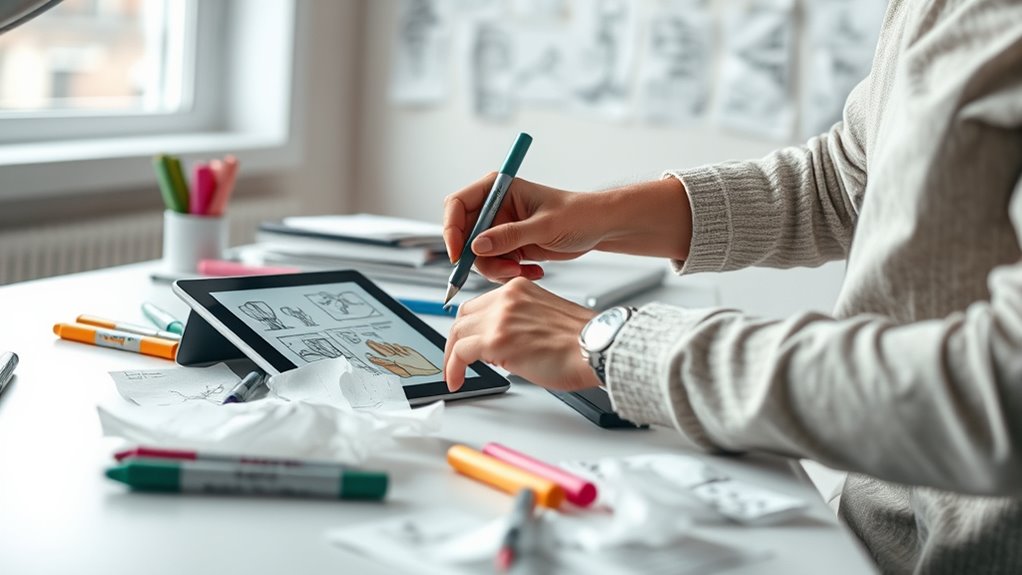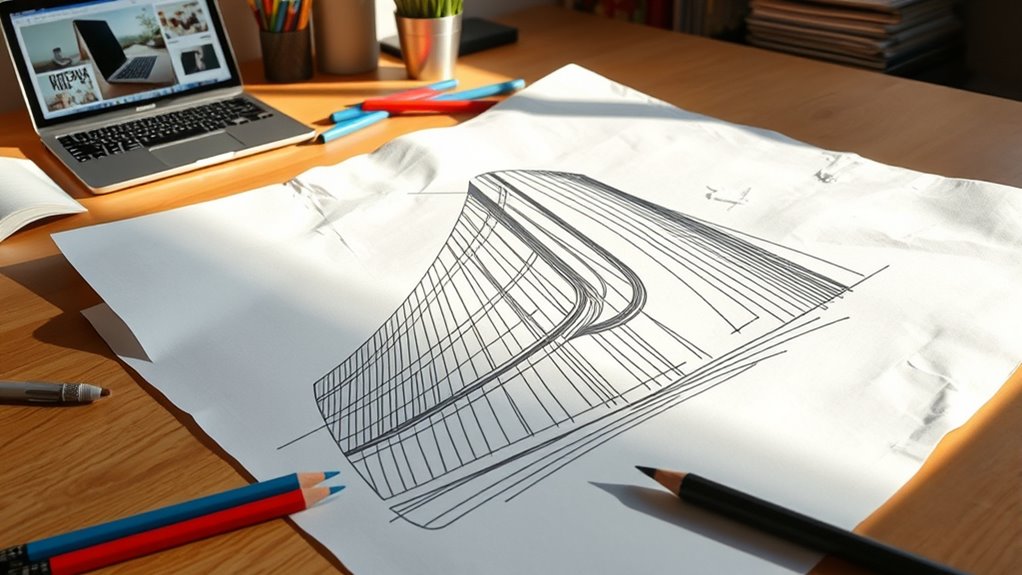To visualize 8 ideas in 8 minutes, set up a distraction-free workspace with essential sketch tools within reach. Focus on selecting diverse, impactful concepts through quick brainstorming and mind mapping. Manage your time tightly with timers, capturing each idea with simple gesture sketches, silhouettes, or annotations. Quickly evaluate and refine your sketches, eliminating weak ideas. Keep your process streamlined to stay efficient. If you want to master these techniques, exploring further will help you boost your speed and creativity.
Key Takeaways
- Prioritize 8 diverse, impactful concepts using quick brainstorming and mind mapping to ensure variety and clarity.
- Set strict time limits (1 minute per idea) with timers to maintain speed and focus during sketching.
- Use rapid gesture sketches focusing on silhouettes and basic shapes, avoiding unnecessary details.
- Keep tools organized and within reach to minimize interruptions and streamline the sketching process.
- Review and refine sketches quickly, discarding weak ideas and building on strong concepts for efficient visualization.
Setting Up Your Speed Sketching Session

Before diving into your speed sketching session, cultivating a comfortable and organized workspace is vital. A calm environment helps you focus and reduces distractions, allowing your creativity to flow freely. Clear your desk of unnecessary items and set up in a well-lit area to see your work clearly. Make sure you have proper tools ready—sketchbooks, pencils, erasers, and any other materials you prefer. Using the right tools makes your process smoother and more efficient. Keep everything within reach so you won’t waste time searching during your timed sketches. A tidy, distraction-free space helps you stay in the zone, making your practice more effective and enjoyable. Additionally, considering your projector setup can enhance your viewing experience and inspire your sketches. Remember, a well-prepared setup sets the foundation for successful speed sketching.
Choosing Your Eight Concepts

Start by brainstorming broad topics to generate a wide range of ideas, then identify which ones could have the most impact. Make sure your choices include diverse perspectives to spark creativity. This approach helps you select eight strong, well-rounded concepts for your speed sketching session. Incorporating well-drained soil knowledge can also help you consider environmental factors that influence the success of your ideas.
Brainstorm Broad Topics
How do you narrow down your ideas to the eight most compelling concepts for your speed sketching project? Start by using mind mapping to visualize all your initial ideas. This technique helps you see connections and group related concepts through idea clustering. As you map out your broad topics, look for patterns and themes that stand out. Focus on clusters with the most potential or interest, as these are likely to inspire strong sketches. Avoid getting caught up in details at this stage; instead, aim for a wide, inclusive view of your ideas. Once you’ve clustered your concepts, select the eight that feel most exciting or impactful. This process ensures your final choices are diverse, relevant, and ready for quick visual exploration.
Prioritize Most Impactful
When selecting the eight concepts to focus on, ask yourself which ideas will create the strongest visual impact and communicate your message most effectively. Use prioritization strategies to evaluate each concept’s potential. Consider factors like clarity, relevance, and uniqueness, then assess their impact through impact assessment methods. Focus on ideas that will resonate immediately and convey your core message clearly. Eliminating less impactful options helps streamline your sketches, making each one more powerful. Remember, your goal is to maximize visual communication with limited sketches. By carefully prioritizing based on potential impact, you ensure your final selection is both compelling and purposeful. This approach saves time and directs your energy toward the ideas that truly matter. Embracing curiosity about visual storytelling can further enhance your ability to communicate complex ideas quickly and effectively.
Ensure Diverse Perspectives
Building on your prioritized concepts, it’s important to guarantee your selection reflects a wide range of perspectives. Incorporating diverse perspectives ensures your ideas are richer and more innovative. To do this, seek out cultural insights that challenge your assumptions and introduce new ways of thinking. Consider ideas from different backgrounds, industries, or user groups, and include them in your eight concepts. This approach helps you avoid narrow thinking and fosters creativity. When sketching quickly, keep an open mind and intentionally select concepts that represent varied viewpoints. By intentionally ensuring diverse perspectives, you create a more thorough set of ideas, increasing the chances of developing solutions that resonate across different audiences and contexts. Additionally, integrating mindful decluttering principles can help you stay focused and organized during the creative process, leading to more effective and innovative sketches.
Time Management and Staying Focused

To make the most of your speed sketching sessions, focus on your key ideas and avoid wasting time on less important details. Minimize distractions by creating a quiet workspace and turning off notifications. Set clear time boundaries to keep yourself moving quickly and maintain sharp focus throughout each sketch. Incorporating mindfulness techniques can further help you stay present and engaged during your creative process.
Prioritize Key Ideas
Have you ever found yourself overwhelmed by trying to capture every detail in a quick sketch? To stay effective, focus on idea prioritization. Identify the core concepts that truly matter, and resist the urge to illustrate everything at once. This helps streamline your concept selection process, ensuring you don’t waste time on less important ideas. When you prioritize key ideas, you create a clear roadmap for your sketching session, allowing you to work efficiently and stay focused. Remember, speed sketching isn’t about perfection; it’s about capturing the essence quickly. By honing in on the most impactful ideas first, you maximize your time and energy, making your sketches more meaningful and your idea development more productive. Additionally, understanding visualization techniques can further enhance your ability to quickly convey complex concepts.
Limit Distractions Effectively
Once you’ve identified your key ideas, maintaining focus during your sketching session becomes even more important. To do this, limit interruptions by creating a distraction-free environment. Turn off notifications on your devices or put them on silent, and close any unnecessary tabs or apps. Managing digital distractions is vital, so avoid checking emails or social media until you’ve completed your sketch. Set a specific timeframe for your session and stick to it, so you’re less tempted to divert your attention. If possible, inform others that you’re focusing and shouldn’t be disturbed. By proactively limiting interruptions and managing digital distractions, you can sustain your concentration, sketch more efficiently, and bring your ideas to life faster. Incorporating techniques like time management can further enhance your focus and productivity during your creative sessions.
Set Time Boundaries
How can you make certain your sketching sessions stay productive? The key is setting clear time boundaries. When working under time constraints, you prevent yourself from overthinking or overworking your ideas, which can drain focus and energy. Establish a strict time limit for each session to combat deadline pressure and keep your sketches sharp and spontaneous. Use a timer or stopwatch to stay accountable, and stick to it. This creates a sense of urgency that boosts creativity and efficiency. Remember, speed sketching isn’t about perfection; it’s about capturing ideas quickly. By managing your time effectively, you ensure consistent progress without burnout, keeping your workflow focused and your ideas flowing freely within the set boundaries. Regularly reviewing your progress and adjusting your goals helps maintain motivation and ensures continued growth.
Techniques for Rapid Visualization

Mastering techniques for rapid visualization requires you to focus on tools and methods that prioritize speed without sacrificing clarity. Use simple visualization techniques that emphasize quick, effective communication of ideas. Choose sketching tools like fine-tip markers, digital pens, or quick-drying pencils that allow fast strokes and easy adjustments. Practice rough sketching to capture core concepts rapidly, avoiding detailed perfection at first. Focus on basic shapes, silhouettes, and annotations to convey your message clearly. Limit your tools to essentials so you can transition smoothly between sketches without distraction. The goal is to streamline your process, making it easy to capture ideas fast and iterate quickly. By honing these visualization techniques, you’ll sketch smarter, not harder, and bring your ideas to life in minutes. Incorporating industry-standard voiceover skills can also enhance how you communicate your concepts in presentations or pitches.
Overcoming Creative Blocks Quickly

Creative blocks can strike even when you’re confident in your visualization skills, slowing down your progress and clouding your ideas. To overcome this quickly, try mind mapping to organize your thoughts and explore different angles. This technique helps you break free from mental stagnation by visually connecting ideas, sparking new insights. Additionally, practice idea incubation—step away from your project for a few minutes or hours. Sometimes, taking a break allows your subconscious to process problems and reveal solutions when you return. Combining mind mapping with quick breaks creates a powerful method for clearing mental clutter and reigniting creativity. This approach ensures you stay agile and productive, enabling you to continue sketching and visualizing ideas without prolonged delays.
Tips for Efficient Sketching and Drawing

To sketch efficiently, focus on planning your approach before you start drawing. Use conceptual shortcuts to simplify complex ideas, allowing you to capture essential elements quickly. Identify key features and omit unnecessary details, saving time and mental energy. Tool optimization is vital—choose the right pencils, markers, or digital tools that feel natural and require minimal setup. Keep your tools organized and within reach to avoid wasting time searching. Practice quick gesture sketches to warm up and improve your speed. Develop a mental library of basic shapes and symbols you can combine effortlessly. Additionally, understanding the best gelato spots in Laguna Beach can inspire vibrant color choices and lively scenes in your sketches. By focusing on these strategies, you’ll streamline your process, create clearer visuals faster, and make the most of your limited sketching time.
Reviewing and Refining Your Ideas

How can you guarantee your ideas are clear and effective before moving forward? The key is thorough review and idea refinement. Step back and assess your sketches critically—look for clarity, strength, and coherence. Seek feedback from others to gain fresh perspectives; this feedback integration helps identify blind spots and improve your concepts. Don’t be afraid to make bold adjustments, discard weak ideas, or combine strong ones. Refining isn’t about perfection but about sharpening your message. Use your initial sketches as a foundation to evolve your ideas into more refined versions. This process ensures your concepts communicate effectively and are ready for the next stage. Remember, reviewing and refining are essential steps in turning quick sketches into impactful visuals.
Applying Speed Sketching to Real-World Projects

Applying speed sketching to real-world projects requires integrating quick, iterative drawing sessions into your workflow. During collaborative brainstorming, use rapid sketches to capture ideas swiftly, encouraging team input and fostering creativity. These sketches help visualize concepts instantly, making discussions more productive. When preparing for client presentations, speed sketching allows you to develop multiple concepts in a short time, demonstrating flexibility and understanding of client needs. It also enables you to adapt ideas quickly based on feedback, streamlining the design process. Incorporate speed sketching early in projects to enhance communication, reduce revisions, and build confidence. By making quick sketches a regular practice, you’ll improve your ability to translate ideas into visuals that resonate with clients and team members alike.
Frequently Asked Questions
What Materials Are Best for Speed Sketching?
When choosing sketching tools, you want options that let you work quickly and smoothly. Pencils are versatile, and fine liners or markers can add bold lines. For paper selection, opt for smooth, lightweight paper that allows easy erasing and quick strokes. Keep your sketching tools simple and portable, so you can capture ideas fast without fuss. The right materials make speed sketching efficient and enjoyable, helping you visualize concepts instantly.
How Do I Improve My Sketching Speed?
You want to improve your sketching speed, yet you’re still stuck in the slow lane. Ironically, the secret lies in embracing gesture flow and rapid iteration. Keep your hand moving freely, don’t overthink, and practice quick sketches daily. Focus on capturing the essence, not details. With time, you’ll find your pace accelerates, and your ideas flow effortlessly—turning slow sketches into swift visual stories.
Can Speed Sketching Be Used Professionally?
Yes, you can use speed sketching professionally. It helps you quickly generate ideas and communicate concepts effectively. With digital tools, you can create collaborative sketches in real-time, improving teamwork and feedback. Many industries, like design and architecture, rely on this technique to save time while maintaining clarity. Speed sketching enhances your ability to present ideas confidently, making it a valuable skill in professional settings.
What Are Common Mistakes to Avoid?
Imagine you’re steering a ship through foggy waters. You need to avoid timing pitfalls that can lead you off course and steer clear of detail overreach that bogs down your journey. In speed sketching, rushing can cause mistakes, while overloading with details hampers clarity. Keep your strokes purposeful and mindful of timing, focusing on essentials. This way, you navigate efficiently, capturing ideas quickly without losing direction or quality.
How Do I Develop My Unique Sketching Style?
To develop your unique sketching style, focus on exploring personal branding through consistent themes and techniques that reflect your personality. Embrace artistic experimentation, trying new tools, lines, and methods to discover what resonates with you. Practice regularly, analyze your work, and don’t be afraid to break conventions. Over time, these efforts will help your style emerge naturally, setting you apart and making your sketches unmistakably yours.
Conclusion
So, after all that hustle to sketch eight ideas in just eight minutes, you might think you’ve cracked the creative code. Ironically, speed often sparks clarity, not chaos. Embrace the chaos, trust your instincts, and remember—sometimes the best ideas come when you’re not overthinking. Keep practicing, and you’ll find that rapid sketches aren’t just quick—they’re your secret to *releasing* innovative solutions faster than you can say “perfection.” Happy sketching!









